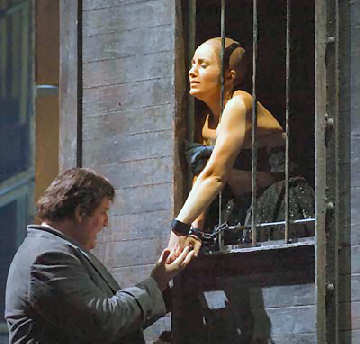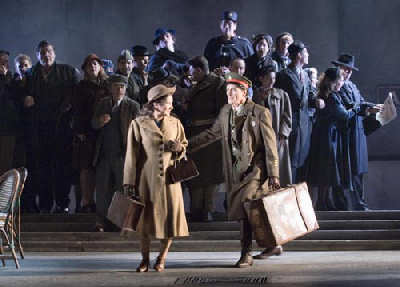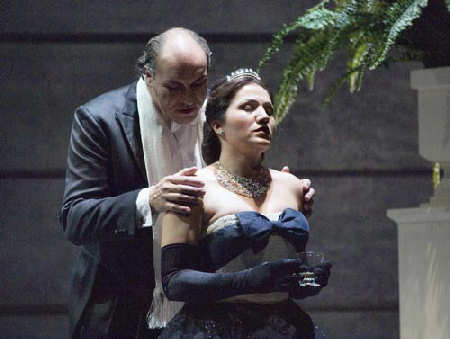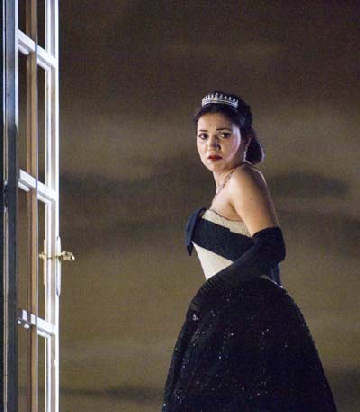Puccini:
Manon Lescaut
at the Norwegian Opera, Oslo,
on 24.9. 2005 (GF)
Musical direction: Olaf Henzold
Direction: Daniel Slater
Sets and Costumes: Robert Innes
Hopkins
Lighting: Simon Mills
Choreography: Lynne Hockney
Fighting instructions: Jeppe
Beck Laursen
The Cast:
Manon Lescaut – Liana Aleksanyan (soprano)
Lescaut – Trond Halstein Moe (baritone)
Chevalier des Grieux – Aleksandrs Antonenko (tenor)
Geronte di Ravoir – Magne Fremmerlid (bass)
Edmond – Marek Lipok (tenor)
The Landlord – Karl Pudik (bass)
A Singer – Katarina Wikström (mezzo-soprano)
A dancing teacher – Gabriel Birjovanu
(tenor)
A Sailor – Eusebiu Cristea (tenor)
Leader of Geronte’s Men – Øystein Skre (bass)
A Captain – Gregg Santa (bass)
Chorus and Orchestra of Den Norske
Opera

Opera productions sometimes are like London buses: you
can wait for ages and suddenly everybody plays the same work.
That happens in the Nordic region this autumn. On September
14th Oslo mounted a new Manon Lescaut,
Helsinki followed suit and actually overlapped the Oslo performances,
beginning on September 23rd and on December 10th
Stockholm’s new Manon will be premiered. Unfortunately
I will not be able to see the Helsinki production this autumn
but I hope it will be played again next season.
Oslo hasn’t seen Puccini’s break-through
opera since 1980 and when it now appears it is basically the
one played by Opera North last season. It plays in Paris, Le
Havre and in French Guyana as originally intended but has been
transported in time to 1945, i.e. immediately after WW2 with
references to what happened in the occupied countries when young
women fell in love with soldiers from the enemy army. Sixty
years after the war this has again popped up in Norway, where the so called “tyskhororna” (German-whores) were castigated and humiliated,
and not only the women but also their completely innocent children,
resulting from the liaison. In this production there is a scene
in the first act, taking place as a pantomime in the background,
where a young woman is surrounded by a group of people and at
the end of the scene she leaves the stage with a placard around
her neck, reading “Collaborator”, a portent of what will happen
in act two when Geronte has Manon
Lescaut arrested and accuses her of also being a collaborator.

We have from the outset been prepared for this since
the opera opens with a filmed sequence from the end of the war,
showing a mob attacking some poor sinners. Once one has accepted
the move in time the production works extremely well. The stage
picture is built around a permanent construction that is a realistic
Café de la Gare (Railway Café) in
Paris in the first act, Geronte’s luxurious apartment in the second, the port of Le Havre in the third and finally
as a ruin in the desert in the fourth act. Everything is extremely
realistic, costumes according to after-war fashion – in the
first and third act quite murky colours, where Edmondo’s
red jacket in the first act stands out from the crowd, as it
should since he acts as a kind of master of ceremonies. It is
smoky, something that further enhances the realistic feeling
but also to some extent affects the auditorium, ventilation
not being particularly efficient in the house. Oslo is sorely
in need of a new opera house and according to plans a quite
boldly designed building will be inaugurated in 2008.
The second act in Geronte’s
upper class dwellings is sharply contrasted to the other acts,
light and posh. This is also the act that feels overlong, not
just in this production, I hasten to add, since the director
does what he can to keep the action alive, but I have always
thought that this is a miscalculation from Puccini – or rather
his librettists. In all his operas there are scenes that serve
more to create atmosphere than carrying the action forward,
but from Bohème onwards he had learnt his lesson and knew how to knit a tauter
drama. Just as in all his mature tragedies there is also some
lighter, more humorous streaks, and the most obvious one is
the scene in Act II when four “ballet” girls in white led by
the singer, perform a parodic pas
de quatre, waving thin veils. Refreshing
and entertaining, making the audience giggle audibly.

There is only one interval, after Act II, which makes
the plot hang together. During the well-known intermezzo, based
on Puccini’s early string quartet movement I
Crisantemi, which here becomes the prelude to the second
part, a new film sequence, also in black and white, is shown.
It is a frightening, slow-moving scene showing, mostly in close-ups,
Manon’s hair being piece by piece cut off, until almost nothing
remains (which was the traditional treatment of the collaborators)
and then, most horrible of all, a heated iron burning the swastika
onto her skull. There is also on stage a fair amount of violence
and cruelty, so much so that a special “fighting instructor”
is listed in the credits. The mass-scenes in Acts I and III
are skilfully handled and there is a lot of well thought through
action taking place behind and around the central drama. In
many productions I get the feeling that some of this business
is there just because the director doesn’t trust the drama to
maintain the audience’s interest and so people have to walk,
or bike which has been fashionable lately. In this performance
everything seems fully integrated and logical.
Olaf Henzold, chief conductor
of the Norwegian Opera since 2001, leads a well-paced performance,
bringing out the Puccinian melodies
in all their glory. Too sentimental? No, I didn’t feel it that
way. There is enough thrust and forward movement to more than
compensate for the saccharine, that
has to be there, after all that is part and parcel of Puccini’s
tonal language. If there is any criticism at all it is rather
that he tends to overpower the singers in one or two instances.
The chorus are good, having a lot to do in Acts I and
III, and they have a lot of individually chiselled parts to
perform, and the many minor solo parts are well executed. The
five major soloists also act convincingly and especially Trond
Halstein Moe as Lescaut
dominates the stage whenever he appears, especially in Act II.
He also sings extremely well with a powerful well-produced baritone
that I would like to hear again in a more meaty roll. Magne Fremmerlid as Geronte is another good actor in a part where he has fairly
little opportunity to show off his singing. This is primarily
a character role and his bass voice is well suited to this character.

These two are the only native Norwegians
in the highly international cast list, where Marek
Lipok as Edmondo, besides being
a wirepuller, also displays a fine lirico-spinto
voice with good ring in his little arietta in the first act.
But in this opera it is of course the two main characters that
are vouchsafed the real lollipops and at the performance I saw
they were in safe hands, or rather throats. The young Latvian
Aleksandrs Antonenko
as Des Grieux is a sensational singer
indeed and seems destined for a great career. He is handsome,
he is a good actor and he has vocal resources that reminds me
of the young Placido Domingo. He sang
all his set pieces brilliantly, powerfully but also with lyrical
warmth. He is already booked to sings this part in Vienna and
also in Stockholm later this year. The even younger Armenian
soprano, Liana Aleksanyan, only 24, had no difficulties to portray the only
fractionally younger Manon Lescaut.
In her impersonation, Manon becomes a very vulnerable creature.
Contributing to this impression is a slight flutter in her voice,
which felt absolutely right, but a Puccini soprano also needs
brilliance to ride the orchestra in the key moments, and when
she opened up she shone like a beacon. Her lower register is
weaker though, and there were moments when Olaf Henzold
could have held back the orchestra to let her be heard. In a
few years time her voice will probably fill out even better,
but she is already a mighty impressive singer, reaching tragic
heights in the long final scene.
There will be no more performances of
Manon Lescaut
this season but hopefully it will be revived in years to come.
Don’t miss it then.
Göran Forsling
Photos: Erik Berg
Copyright: Den Norske
Opera
www.operaen.no






